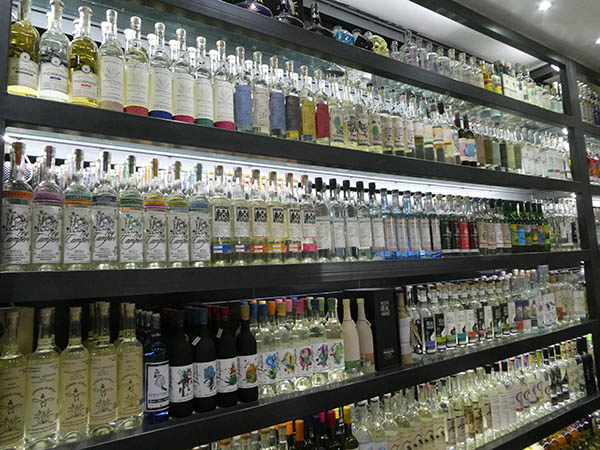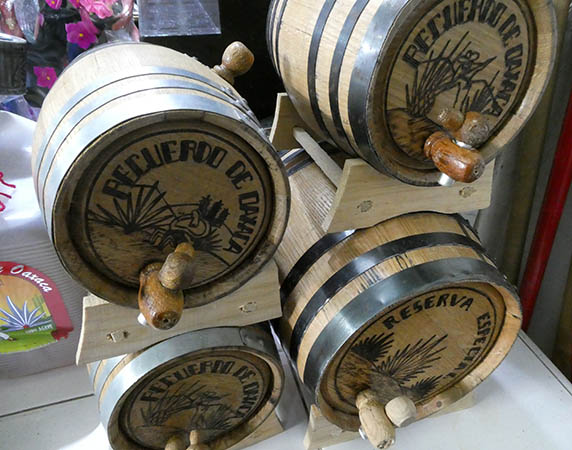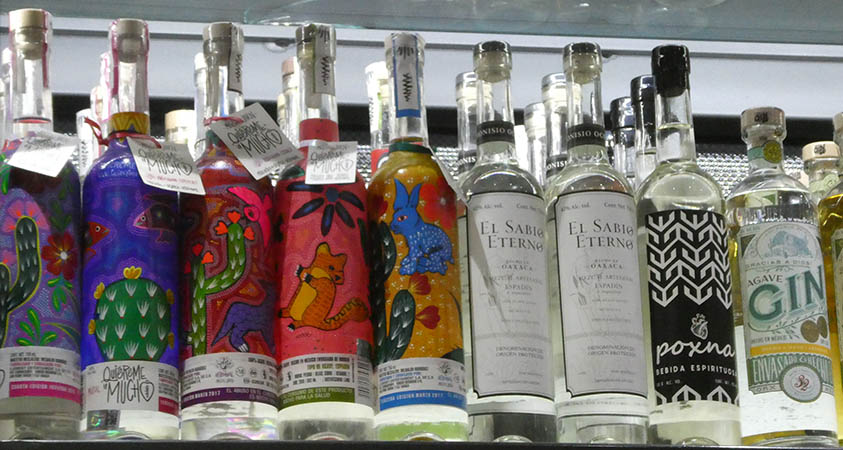|
Retire Early
Lifestyle
Retirement; like your parents, but way cooler

|
In 1991 Billy and Akaisha Kaderli retired at the age
of 38. Now, into their 4th decade of this
financially independent lifestyle, they invite you
to take advantage of their wisdom and experience. |
|
You don't
find Mezcal.... Mezcal finds You
The
Traditional Drink of Oaxaca, Mexico
Billy and Akaisha Kaderli

As you may already know,
Billy is a trained French Chef and we owned our restaurant in the Monterey Bay
area of California for a decade. We weren't far from Napa Valley, and made
regular visits to taste and purchase wines for our business.
In general, we travel the
world tasting foods in the local area and drinking their beers, wines or
spirits.
Oaxaca,
Mexico, is a gastronomic powerhouse now, known for its
international cuisine and for its
mezcal.
You will enjoy this little
summary and insight into this ancestral drink of Oaxaca.

Bottles and bottles and bottles of Mezcal for sale
While most North Americans
don't know much about
Tequila
(how it's made,
how
to sip it, or
the
history of it), at least they have heard of the drink.
Mezcal is a whole other
world and one would be hard pressed to find a native of the States or Canada who
could describe it.
There is a saying that you
don't find Mezcal.
Mezcal finds you.
While
Tequila can
only be made from the blue agave plant, Mezcal, tequila's rustic cousin is made
from one of the other 150 species of agave native to Mexico.
Eleven different varieties of agave from which
Mezcal can be made are native to the Oaxaca, Mexico region. This abundance
delivers 80% of all Mezcals to be made here.

Restaurant sign says: Mezcal, Gold of
Oaxaca
Mezcal can best be
understood by simply tasting it next to tequila.
It's a smoky flavor, like a
campfire, but some Mezcals are more subtle and gentle.
The native inhabitants of the Oaxaca area began distilling
spirits approximately 400 years ago. They took the techniques
they’d learned from Spanish conquerors and utilized the available ingredients
in their environment.
The Spanish themselves began
creating Mezcal when the supplies of liquor they had brought over ran out. To
avoid conflict with the Spanish Crown, they opted to use the agave plant instead
of grapes or sugar cane.
Oro de Oaxaca Mezcal began in 1985 and is
considered to be one of the “scorpion Mezcals”

Los Amantes Mezcaleria
"The Lovers" is an artisan Mezcal, made
from 100% Espadín agave the most prevalent agave variety found in Oaxaca.
Although there are
corporate businesses making Mezcal, in artisanal Mezcal production the pinas are
cooked in an underground, earthen pit.
The volcanic rock lined pit
is usually about ten feet wide and ten feet deep, cone-shaped down to the
bottom. A fire is started in the bottom with wood and burns to embers heating
the volcanic rocks to extreme heat. The pinas are then piled into the pit and
covered with about a foot of earth. This underground “oven” now smokes, cooks
and caramelizes the pina over a multi-day cooking process, imparting that smoky
flavor.

Downstairs restaurant in a hotel
Mezcal is available in even
the most humble of restaurants.
As in California's Napa
Valley, every restaurant offers wine by the glass and wine by the bottle, it's
the same here in Oaxaca with Mezcal. It's a good way to taste a variety of them in case
you want to purchase a bottle at a later time of something you enjoyed.
In the States, premium
Mezcal can go for $50, $100, or even $200 a bottle, and some feel they are
paying for a bottle of drinkable art made in the traditional manner since the
1600’s.

Mezcal tasting room
Mezcal is a spirit regulated by the Mexican
government, and these rules went into effect in 2003.
This regulation has become controversial for
several reasons. The smaller artisanal provider cannot afford the certification
and they have been making this beverage for generations. Others feel that the
term "Mezcal" should not be owned by the state.
Since these uncertified makers are prohibited
from using "Mezcal" on their products, they might use a term like "destilados de
agave" or "agave spirits."

Rows and rows of Mezcal for sale
Some Mezcals are bottled
with a small larva and are referred to as Mezcals con gusano, meaning
“with worm".
This tradition is also
controversial for various reasons, as the gusano changes the taste of the Mezcal.
But then there is another style of distillation that includes vapor running over
animal meats such as a chicken breast or a piece of lamb. This too, changes the
taste of the final product giving a hint of smoky BBQ.
So you see, there is not
just one way a Mezcal is made or preferred.
Probably most of these
"arguments" are had after a few copitas of mezcal have been imbibed!
The best Mezcal is the one
you like, and for the reasons you like it.

Crema de Agave Mezcal
Cream liqueurs have been
popular for decades. The most well known is Irish Cream, and in the Caribbean
rum creams are the rage.
In
Oaxaca, there are a wide variety of Mezcal-based cream liqueurs. Flavors run
from mocha, cappuccino, pina colada, banana, guanabana, nut to sweet purple
grape.
Mescal creams are generally
low-proof, averaging between 12 and 18 percent alcohol. Their sweet pleasing
flavor make them a perfect after-dinner treat. Some folks like to enjoy them
over ice cream for dessert. Mezcal creams are not widely sold in the USA.

Lots of crema de agave
Here you see more bottles of agave cream with
pistachio mint, strawberry, nopale fruit, coconut and other tropical
combinations.

400 Conejos Mezcal
Since this is a long-standing traditional
drink of the inhabitants of
Oaxaca,
Mescal comes with a few wild stories.
In the olden days, the priests or shamans of
the villages would use Mezcal to communicate with their spirit guides. Such
drinks were exclusively for religious ceremonies and for the spiritual elite.
There is an ancestral belief that agave
spirits were occupied by 400 rabbits. Those who ingested this distilled agave
would be controlled by one of the 400 rabbits, but no one ever knew which rabbit
you'd get with each Mezcal.
Each rabbit had a different personality and
way of making you think and act.
So I guess if one misbehaved, they wouldn't
say "The devil made me do it" - they would blame a rabbit!
400 Conejos is considered to be a rare Mezcal,
made in Matatlan, Oaxaca and not exported.
This Mezcal is sipped and served with slices
of orange and sal de gusano. I have had it in this way, and it is simply
delicious. Most worth the experience.

Aging barrels for Mezcal
The aging of spirits go back a long way.
Scotch, brandy, tequila, bourbon - even wine and some beers are aged in barrels.
This imparts another flavor to the spirit,
depending on
if the barrels are smoked or if they held wine or sherry previously.
Mezcal purists seem to think that aging
disqualifies this agave drink from being considered a quality sipping spirit.
Their reasoning goes along the lines of aging in barrels masks the natural
flavors of the agave itself.
These sorts of arguments remind me of my
childhood when scholars used to get all heated up over the question "How many
angels are there on the head of a pin?"
But apparently, to some, this aging of Mezcal
business is a big deal.
Back in the olden days, the distilled liquid
was stored and transported in clay pots called "cantaros." But the cantaros were
limited in size and were very vulnerable to breaking, hence the desire for
barrels.

Specialty bottles of Mezcal
On the right hand side of this photo you will
see Gracias a Dios Agave Gin. Now to be a true gin, it must be grain-based, and
this one is made from agave. I'm sure the purists don't like this idea either,
but "Thanks to God Agave Gin" is agave and with 32 botanicals.
Some of the botanicals listed are corn,
basil, epazote, chamomile, lime peel, orange peel, chaya, cinnamon, huizache,
lemon balm, hoja santa, eucalyptus, cilantro, and alligator juniper tree.
On the left hand side are Quiereme Mucho
Mezcals. These are painted by local artists using ancient techniques to create
magical figures called Alebrijes. Their Mezcal is 100% organic and because each
bottle is hand-painted, they all look slightly different.
El Sabio, in the center, means wise man. This
must go back to the spiritually elite idea to communicate with the gods.
So I hope you enjoyed this little tour of
Mezcals. Perhaps you'll give them a try the next time you see them on a drink
menu.
I do recommend tiny sips, with a slice of
orange on the side. It brings out a whole different quality to your experience.
For more photos and stories of Oaxaca,
CLICK HERE
For more photos and stories on Mexico,
CLICK HERE
For photos, fincas, stories, history and
more about Tequila,
CLICK HERE
For more on
Retirement Topics,
click here and
here and don't forget to signup for
our free Newsletter.


About the Authors



Retire
Early Lifestyle appeals to a different
kind of person – the person who prizes their
independence, values their time, and who doesn’t
want to mindlessly follow the crowd.
HOME
Book Store
Retire Early Lifestyle Blog
About Billy & Akaisha
Kaderli
Press
Contact
20 Questions
Preferred
Links
Retirement
Country Info
Retiree
Interviews
Commentary
REL
Videos
|